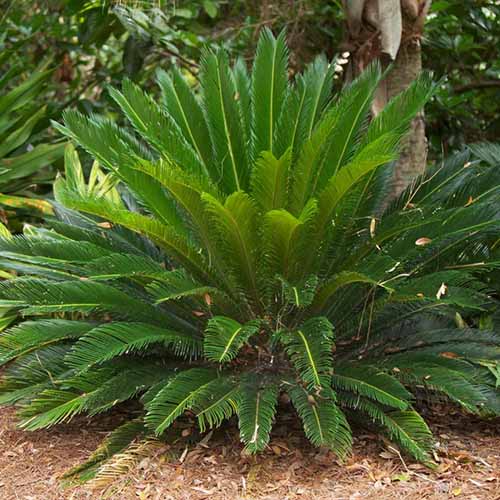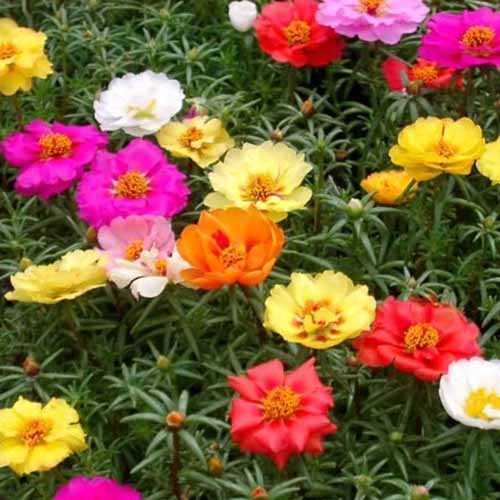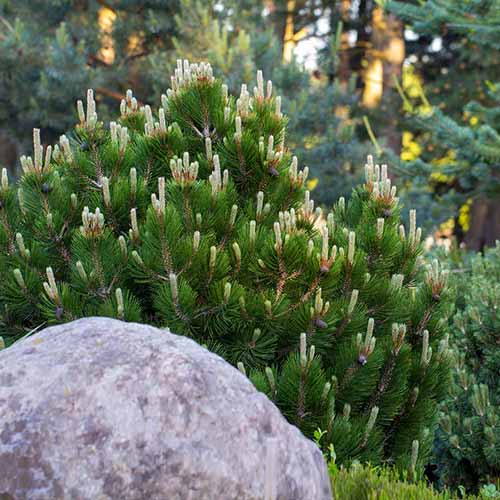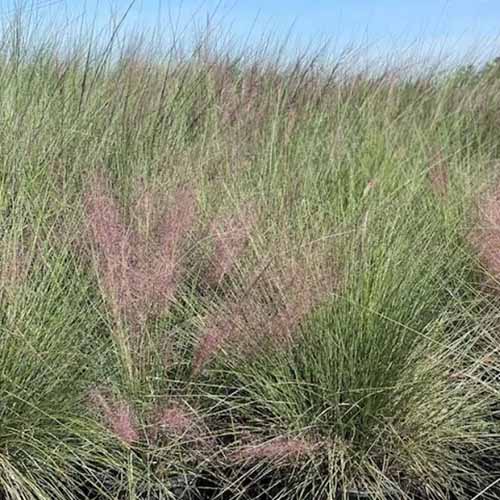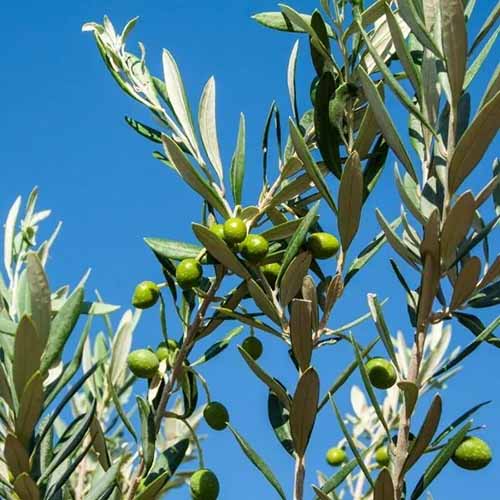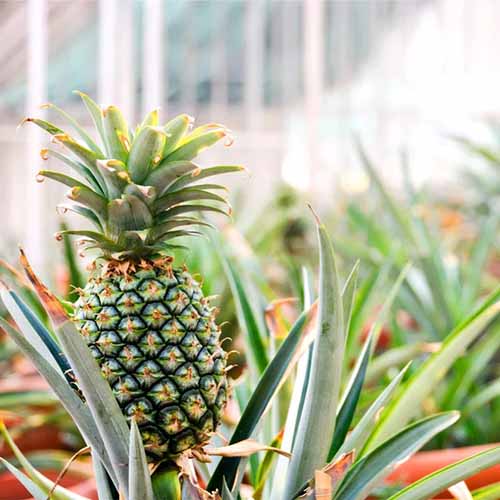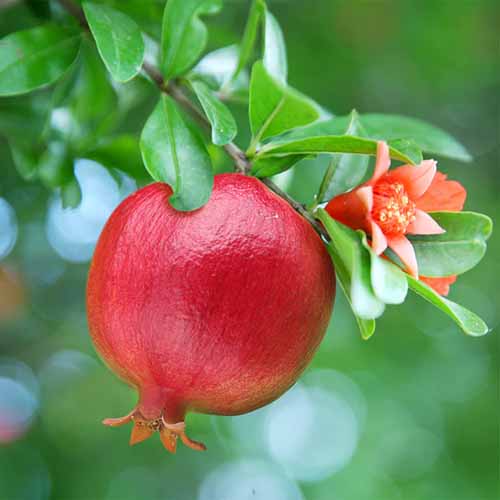They’ll send out offshoots to continually self-propagate, but after they bloom, the parent plant will die off. Be prepared to remove dead specimens as they wither.
Learn how to grow kalanchoe in our guide.
12. King Sago
Sometimes referred to simply as sago palm or Japanese sago, the king sago (Cycas revoluta) isn’t a true palm, it is a cycad. This living fossil has been around since dinosaurs roamed the Earth.

It’s extremely slow-growing and can sometimes take more than 50 years to reach its mature height of about 15 feet. In xerophytic gardens, it’ll normally remain more compact at five to eight feet in height.
One of the key differences between cycads and some types of palms is reduced water consumption in the former, so a king sago can be grown in arid regions more easily. However, in regions with very harsh sunlight, they prefer some shade.
Some palm trees such as the date palm (Phoenix dactylifera), which is best known for the date fruits it produces, are also xerophytic and can withstand extended drought conditions.
King sagos are beautiful specimens. Long, palm-like leaves sprout from the top of a roughly textured trunk and these can sometimes reach five to seven feet in length.
Male plants produce a reproductive structure that resembles a yellow cone up to two feet in length, while females produce a fuzzy globe full of orange seeds.
King sago is suitable for cultivation in Zones 8 to 11. It’s super hardy down to about 15°F and can sometimes withstand temperatures even lower.
This species can also hold up to temperatures well over 100°F, but it may need some shade.
Note that this specimen is known to contain toxins, so keep people and pets away.
Pick up a sago palm in a three-gallon container from Fast Growing Trees.
You can learn more about sago palms here.
13. Moss Rose
These easily recognizable, ferny semi-succulents with brightly colored blooms often go by another name – portulaca (Portulaca spp.).
Native to Brazil, Argentina, and other semi-arid regions, it makes sense that they’re xerophytic.
While they’re not quite as conservative in their water consumption as some of the other species we’ve covered, they do store water in their leaves and stems, and enjoy full sun, heat, and well-drained soil.


Common purslane (P. oleracea) is a close relative, which you might be fighting to keep off of your driveway or sidewalk – but don’t fight too hard, because it’s edible!
One of the most popular species, P. grandiflora, thrives in Zones 4 to 10. It’s a low-growing type that reaches only eight inches or so at full height.
Because it spreads, this species can create a wide carpet of protection over dry ground where little else grows – sometimes several feet in width.
You’ll see blooms of red, yellow, orange, white, or magenta opening in the summer months, and a lovely blue-green mat of delicate foliage at other times of year.
In warmer regions they’re considered evergreen perennials. But in gardens north of Zone 8, they’ll die off in the winter.
Packets of moss rose seeds with double blooms in a mix of colors can be purchased from Eden Brothers in one ounce and quarter pound sizes.
Learn more about moss rose care here.
14. Mugo Pine
Pine trees are often xerophytic, but can be huge when mature, and not everyone has space for a specimen of such proportions.
For a smaller garden or landscape, a mugo pine (Pinus mugo), or dwarf mugo pine cultivar such as ‘Compacta,’ can be a blessing.


Another benefit offered by this shrubby species is its range. If the intended site is within Zones 2 to 8, it’ll grow almost anywhere, but it is particularly at home in dry, rocky, mountainous regions as a native of central Europe.
Full sun or partial shade is preferred.
A low-maintenance, structurally gorgeous pine like this can easily become the anchor for a bed full of shape and color, or as a windbreak.
Let it grow freeform and create thick, needle-laden branches with upright pinecones developing at the tips in the fall, or prune it for an effect similar to bonsai.
Mugo pines will typically reach about 20 feet in height at maturity, though they’re very slow growing. Dwarf ‘Compacta’ typically tops out at no more than about four feet.
Pick up a dwarf mugo pine (P. mugo var. pumilio) in one- or three-gallon containers from Fast Growing Trees.
We delve deeper into growing mugo pines here.
15. Muhly Grass
Muhly grass (Muhlenbergia spp.) might resemble cotton candy clouds like something out of Willy Wonka’s edible landscape, but these fluffy puffs are much tougher than they seem.


The soft, misty panicles can range in color from green to white, or even dreamy reddish pink as seen in pink muhly grass, aka M. capillaris.
More than 150 different varieties of muhly grass exist, so you’re bound to find a perfect one for your needs.
Whether you have clay, sand, or even fire-scorched earth, this ornamental grass will thrive. Sometimes, it thrives so much that it spreads out of bounds, so keep an eye out for the semi-invasive tendencies.
Heat, pests and diseases, deer and wildlife, drought, salty soil – nothing seems to phase it. Add it as a border in an area where the sun sets behind it for a blaze of magical color.
Muhly grass is also right at home in beds, as a living fence, in rock gardens, and in so many other places.
Most types can reach heights of up to four feet with a similar spread in Zones 6 to 11.
You can pick up Regal Mist® pink muhly grass in #5 containers from Nature Hills Nursery. This cultivar is also known as ‘Lenca.’
16. Olive
If you’re looking for a grand-scale specimen that provides shade, structural interest with a gorgeous, gnarly, twisted trunk, and a potential food source as well, then an olive tree (Olea europaea) might be exactly right.


Olive trees are available in fruiting or ornamental types, so if the form is appealing but the fruit is not, you have options.
These trees have been cultivated in arid regions, like the southern Mediterranean and the Sahara Desert, throughout recorded history.
Most develop a single trunk, but some, like the ‘Manzanillo’ olive, can develop multiple trunks. They have wide canopies, reaching about 25 feet in width with an equal height.
Grow shade-loving xerophytic herbs like sage, rosemary, and thyme under the canopy or brighten up the planting area with suitable flowers.
Gardeners in Zones 8 to 11 can grow most types of olive trees, since they need full sun, long, hot summers, and sandy, well-drained soil.
‘Mission,’ for example, is one cultivar that can tolerate lows to about 8°F, so this is a good choice for growing a bit further north.
A fruiting ‘Manzanillo’ in a #1 container is available from Nature Hills Nursery.
‘Manzanillo’ olive trees are of Spanish origin, and the fruits of this cultivar have been developed for meaty flesh, an easy to remove pit, and uniform shape and color. It’s the most popular olive in the world for commercial production.
Fruits are produced in the fall, following a flush of small, white blooms. The foliage remains evergreen.
‘Swan Hill’ is a cultivar that was bred for beauty without producing olives.
It has the same lovely, gnarled trunk and evergreen foliage as other varieties but it produces a very minimal quantity of pollen, so allergy sufferers may want to consider this as a possible choice.
Learn how to grow olive trees here.
17. Pineapple
Did you know that pineapple plants (Ananas spp.) are succulents in the bromeliad family, Bromeliaceae? Well, they are, and they’re also xerophytes!


Even though the foliage of a pineapple plant isn’t typically as colorful as that of most other bromeliads, the developing fruits are both colorful and gorgeous.
Plus, you get pineapples – that’s a pretty good reason to include them in your garden, right?
It can take about two years for a fruit to fully develop, but in that time, the large, toothed leaves can grow to between three and six feet in height with about the same spread.
Several of these grouped together as the background for a brightly planted bed can make a stunning architectural backdrop.
Ornamental species such as the red pineapple (Ananas bracteatus) offer all of the beauty and smaller, less fleshy fruit – though it is still technically edible.
Provide full sun and sandy loam for pineapples.
You can find A. comosus ‘Florida Special’ aka Sugarloaf pineapple available in one- and three-gallon containers from Fast Growing Trees.
Our guide to growing pineapples has more information.
18. Pomegranate
Pomegranates (Punica granatum) are attractive, functional, and productive.
These ancient trees have been cultivated since the Bronze Age, from the first recorded species that appeared in the Middle East.
During the hottest, driest times of year, it’s best to offer some water to prevent cracked fruit, but otherwise, they’re very conservative in their needs.


Ornamental pomegranate trees are also a possibility, if you’d like the appearance without the edible fruits.
Cultivars such as the dwarf ‘Nana’ produce showy blooms, pretty green foliage, and inedible, mini fruits that add interest throughout the fall and winter in warm climates.
Less space is needed to grow them as well – maximum mature height is only three to four feet.
Both the dwarf and full-size species plant and cultivars can typically withstand temperatures in Zones 7 to 11, as long as they’ve got a nice sunny spot and well-drained, sandy soil.
Surround them with flowers or succulents in tones of blue and green for a stunning pairing.
‘Texas Pink’ reaches a modest height of just 15 feet at maturity and bears pink globe-shaped fruit.
You can find ‘Texas Pink’ pomegranates in a variety of sizes at Fast Growing Trees.
Learn more about growing pomegranates here.
19. Prickly Pear Cactus
Another that offers both form and function is the prickly pear cactus (Opuntia spp.) also known as opuntia, paddle cactus, and Indian or Barbary fig.
Prickly pear fruits and pads are edible, so in a garden that’s designed to pull double duty, offering water-thrifty beauty and food, these true cacti fit the bill.


We have dedicated guides with full instructions for you on harvesting both the pads, or nopales, and the fruits, or tunas, including how to process these tasty treats.
Opuntia species are indigenous to North, Central, and South America, and can withstand incredibly long periods of drought, intense sunshine, high heat, and sometimes, frost or even snow.
Plant in full sun and sandy substrate with good drainage. Avoid overwatering as too much water can cause prickly pear plants to weaken and lose structural integrity.



